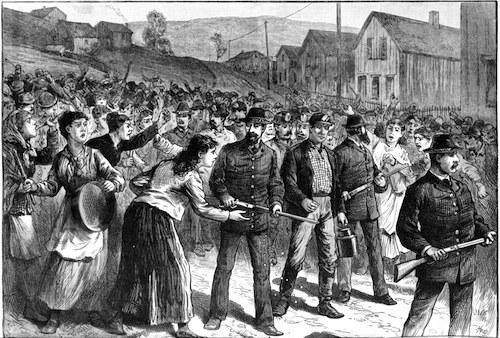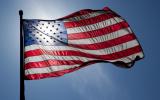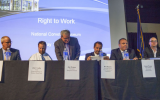Bad Seeds

Organized Labor was Rotten from the Beginning
By Abby Streu
Many people think the corrupt national union as we know it today did not magically appear overnight. Or did it?
Before the American Revolution, in England, there were no unions, but similar groups called guilds were common. As explained by S.R. Epstein in his book Guilds, Innovation, and the European Economy (1400-1800), guilds first came into existence during the Medieval period.
Guilds were associations of craftsmen and merchants, formed to promote the mutual benefaction of people in similar industries. These organizations regulated the relationships between the different levels of workers within the trades’ community as well: apprentices, journeymen and masters.
Apprentices were typically adolescent boys whose parents paid for him to be taken on as a student of a particular trade. Journeymen were paid workers who had successfully completed an apprenticeship, but were not experienced enough to become masters. Masters had years of experience, and were the only tradesmen allowed to be members of the guild. To be a master, one had to be voted into the guild by the current members.
(The English colonies in America had similar guilds and apprentice-master arrangements. Benjamin Franklin famously worked as an apprentice printer for his brother’s printing shop. At age 12, he signed a contract binding him as an apprentice for 9 years.)
A group of journeymen printers in New York City banded together to demand a pay raise in 1778, a few years after the American Revolution began. The group was made up of numerous journeymen employed by different master printers. They initiated a strike—which was successful—and the group disbanded immediately after their victory.
After the war in 1786, in Philadelphia, 26 printers came together to strike for higher wages. They advertised a declaration on June 2, 1786, demanding a minimum of $6 per week, and refusing to work at any printing office in the city until they achieved that goal. They were successful.
The Federal Society of Journeymen Cordwainers was formed in 1794 in Philadelphia due to the increasing need for journeymen shoe and bootmakers. As the demand for shoes grew in America, master shoemakers sought to expand their business by increasing their supply and exporting to other cities and towns. To accomplish this, they would hire numerous journeymen shoemakers to fulfill the desired quota. Exporting the shoes, however, increased production costs. To compensate, employer shoemakers reduced the wages of the journeymen.
In 1805, members of the Philadelphian chapter of the society began to heckle workers who did not adhere to the organization’s goals. Non-compliant workers were labeled as “scabs,” and were plotted against by more dedicated members of the group. According to a transcription of the trial taken down by Thomas Lloyd, a journeyman named Anthony Bennett later testified that the recruitment committee from the society “threatened to [kill me].”
In the winter of 1805/1806, the Philadelphia Cordwainers instigated a strike to attempt to increase their wages. When fighting broke out in the streets between the strikers and “scabs” in January of 1806, the Philadelphia chapter’s leaders, Underl Barnes, John Dubois, John Harket, John Hepburn, George Keimer, Peter Pollen, George Pullis and George Snyder, were arrested on the charge that they conspired to restrain trade.
Due to the plots against disobedient workers, fighting, and the collapse of the strike, the Philadelphian leaders were tried for conspiracy in late March of 1806 in the trial Commonwealth v. Pullis, called “The First American Labor Court Case” by Walter Nelles.
Thomas Lloyd’s account of the trial showed that the prosecution provided 13 different journeymen and shop owners, each of whom testified against the society’s leaders. One journeyman, Job Harrison, stated that a “tramping committee” came by the printing shop he worked at, which was owned by John Bedford. The committee told him that it was his “duty” to show up to the society’s meetings, and that if he didn’t, he would be “liable to be scabbed.” He described “scabbing” as being socially ostracized. John Bedford claimed that the committee threw potatoes with broken shoemaker’s tacks through his window.
The society’s leaders were found guilty. Their punishment required them to each pay $8 to the Commonwealth and the court costs.
Early Unions Get Political
In 1828 in Philadelphia, the first labor-related political party was created. Called the Workingmen’s Party, members promoted “universal male suffrage, equal educational opportunities, protection from debtor imprisonment and compulsory service in the militia, and greater financial security and shorter working hours.” After the formation of the Philadelphia group, a few more independent Workingmen’s Parties were created, most notably one established in New York City.
In Philadelphia, the Workingmen’s Party did not put candidates up for election, but endorsed individuals running who promised to support the interests of laborers. The New York Workingmen’s Party, on the other hand, was able to successfully elect Ebenezer Ford to the State Assembly in 1829.
The first official independent trades union, the Mechanics’ Union of Trades Associations, was formed in 1827 in Philadelphia. In 1834, many of these local unions joined together to form the National Trades Union (NTU). This was the first attempt for organized laborers to create a national confederation of unions.
On numerous occasions, employers took legal action against unions, claiming criminal conspiracy, such as in the case aforementioned, Commonwealth v. Pullis (1806).
In Commonwealth v. Hunt (1842), the Boston Journeymen Bootmakers’ Society demanded that an employer fire one of his employed bootmakers. The employee was a member of the society, and had disobeyed the rules of the group. The society was charged with conspiracy and the Boston Municipal Court found them guilty. The presiding judge of the appeal, Justice Lemuel Shaw, determined that the act of organizing for striking was not conspiratorial.
A year after the Civil War ended, the National Labor Union (NLU) was formed. By this time in 1866, there were over 200,000 members of labor unions across the country. Employers shared lists of union members with one another, so if those members showed up to work in a nearby town, the employer would be able to know their affiliation. In an attempt to deter this, the NLU was formed as a large group of different unions to protect the membership of the workers involved.
The NLU took firm political stances. There was one attempt to push political candidates from the group, but votes were low. A member of the NLU, Richard Trevellick, worked as the Union’s lobbyist, spending his time convincing politicians to aid labor-related issues. The NLU took stances on (white) women’s suffrage and included women in their ranks.
Susan B. Anthony was a delegate in the Union’s congress, representing the female faction of the NLU. However, in 1869 the founder of the union, William Sylvis, passed away, creating a rift between the male and female members of the group. Anthony was asked to step down from the Congress and her female supporters left with her in 1870. In 1872, the NLU faded from existence due to falling membership after the gender-based political complications.
War in Coal Country
In the 1860s and 70s, the Molly Maguires, a group of Irishmen coal miners in Pennsylvania, took the phrase “by any means necessary” far too seriously. Both working conditions and wages were abysmal—it was long, dangerous, taxing work for pay that barely covered a family’s living expenses.
The “Mollies” carried out robberies and murders to achieve their goals. Mine owners, laborers, and community members alike were wounded or killed because of the group. A Philadelphia newspaper, The Evening Telegraph, on March 25, 1867 reported that “the proprietor of the Burrell Tavern… had his house surrounded by a party of six or eight of the refractory miners known as the ‘Molly Maguires’ on Friday night. He was ordered to surrender all his valuables to the men.” The proprietor ignored the demands of the gang, grabbed his shotgun, and fired twice into the group, hitting two men. One was wounded, the other killed.
The society thrived in the taverns of the five counties in Pennsylvania they reigned over. Places such as the Burrell tavern were the meeting places of the gang. They recruited new members as they drank after work.
The Daily State Journal reported on August 14, 1872 that “six men returning from the Gowell and Audenreid Mines… were fired into by a party of Molly Maguires. The men had been at work, contrary to the orders [of the gang],” in Ashland, PA. One man was killed and another wounded.
Their havoc over Pennsylvania ended when multiple mine owners hired a private detective from the Pinkerton National Detective Agency to infiltrate the Maguires. This man, James McParland (alias James McKenna), testified against the gang in the “Molly Maguire Trials of 1876” after penetrating their inner circle.
James McParland recounted his undercover operation as he was questioned in the trails. He spoke of how he created a thuggish personae, and befriended a local saloon owner, Muff Lawler, who was able to get him a job at a local mine. Lawler also introduced McParland to John Kehoe, the leader of the Molly Maguires. On April 14, 1874, McParland was ordered to get on his knees, was read the laws and testaments of the group, and ordered to kiss the document. This made him an official member of the organization.
McParland testified that members of the society were often ordered to commit violent acts for the group, such as the murder of Benjamin Yost, a police officer who had attempted to arrest a few Mollies, or the murder of a mine superintendent by name of John P. Johns.
The Molly Maguires ceased to exist in 1876 after the trial. Fourteen of their leaders were convicted. Ten were hanged.
Crusaders for Labor
The Knights of Labor (KOL), began as a secret society of Philadelphian tailors in 1869. At the end of the 1870s, the hostility of American workers grew, and the membership of the Knights grew along with it. Membership accelerated even more with the Railway Strike of 1877.
The Great Railway Strike was instigated by the Baltimore and Ohio Railroad announcing a wage cut. Strikes occurred all over the country in protest, but began in West Virginia. The West Virginian Militia was summoned, but did very little to stop the striking as most of the militiamen sympathized with the railway workers. The governor at the time, Henry Matthews, called for federal assistance. President Rutherford B. Hayes deployed aid soon after.
By the time federal troops arrived in West Virginia, groups of workers in other parts of the country had started striking as well. Most notable were cities like Baltimore, where violence broke out between the militia men and railway workers. In Columbus, OH, strikers wrecked railway property. Control of cities like Pittsburgh, PA and St. Louis, MO was temporarily confiscated by strikers. In the end, around 100 people were killed during the three weeks of the strike.
Terrance Powderly was elected the Grand Master Workman of the KOL in 1879. He transformed the society into a union and greatly increased the membership to around 700,000. The KOL’s membership was different from most unions at the time, as it included workers of all different industries. This was a precursor to the type of unions we see in the present, such as the American Federation of Labor and Congress of Industrial Organizations (AFL-CIO).
Powderly disapproved of strikes, but the KOL still carried out several successful railway strikes under his leadership. He was able to learn from the Great Railway Strike of 1877. However, the Great Southwest Railway Strike of 1886 brought about the downfall of the KOL. In March of 1886, a railway worker in Texas was fired for initiating a KOL meeting. This lead to a group of members destroying a train engine to halt railway operations. They began burning bridges in protest. Over the next few months the strike carried on, but due to internal fighting, the Union ceased to exist by August of that year.
In 1881, the Federation of Organized Trades and Labor Unions (FOTLU) was formed. This would later become the American Federation of Labor (AFL) in 1886. Samuel Gompers became the vice president of FOTLU at its creation. He took the lead in growing the Union, and when it became the AFL, he became its president. Many members from the Knights of Labor deserted that union to join the AFL. Gompers promoted the concept of a closed shop in agreements between employers.
This, of course, cut out any worker who would get in the way of union leadership by choosing to ignore strikes or boycotts. Individual bargaining was looked down upon from Gompers’ union throne. He also promoted all employees paying dues, regardless of their membership in the organization.
The Bureau of Labor was established in the Department of the Interior in 1884 through the Bureau of Labor Act. It was designed to compile economic data concerning labor. Four years later, it became its own department, which remained intact until 1903 when the Department of Commerce and Labor was formed.
In 1892, the Homestead Strike was instigated by the Amalgamated Association of Iron, Steel, and Tin Workers at the Carnegie Steel Mills. Several guards and strikers were killed, and the Union was kicked out of numerous mills in Pittsburg.
In 1898, Congress passed the Erdman Act, which prohibited railway companies from discriminating or terminating the employment of union members, but this portion of the Act was immediately declared invalid by the US Supreme Court. The rest of the Erdman Act dictated that any unrest or dispute over labor required mediation if it interrupted interstate commerce. The Erdman Act was a precursor to the Railway Labor Act of 1926.
Big Government Meets Big Labor
In 1903, the Department of Commerce and Labor was created by the United States Congress, and lasted until 1913 when the United States Department of Labor was signed into existence by President Howard Taft.
During World War I, in April of 1918, President Woodrow Wilson created the National War Labor Board. Its purpose was to attempt to prevent strikes that would halt war-related production. It dissolved in May of 1919. It reappeared during World War II for the same purpose. The Board was made up of representatives from labor unions, industrial companies and the general public. The labor representatives were able to negotiate for better working conditions, and unions gained over 2 million new members during this time period.
The Railway Act of 1926 was signed by President Calvin Coolidge in response to numerous railroad stoppages. Unions and employers drafted the legislation together, creating a document that protected the rights of workers to unionize while also promoting civil negotiation.
In the early 1930s, Senator Robert Wagner (New York) began drafting National Labor Relations Act (NLRA), but in 1933, FDR created and passed the National Industrial Recovery Act (NIRA). It cleared the House of Representatives with a vote of 325 to 76 and the Senate with a margin of 7 votes.
The NIRA gave the federal government the authority to monitor prices and manufacturing in industry. With the NIRA, President Roosevelt created the National Labor Board in an attempt to mediate union-employer disputes that fell under section 7(a) of the Act, which guaranteed collective bargaining rights. FDR made Wagner the chair of the NLB. The Board ended up failing at ensuring collective bargaining rights. If employers violated the Act, their only punishment was them being revoked of displaying a compliance symbol on their products. In the end, only 4 companies lost this privilege.
In February of 1934, Wagner presented the NLRA to the United States Senate as an alternative.
On February 14 and 15, 1934, the first National Labor Conference was held. Each state was to provide one delegate for the event, and in total 39 delegates arrived. The Secretary of Labor, Secretary Perkins, initiated the meeting to discuss the individual labor needs of each state to enhance Wagner’s labor legislation.
In 1935, the NLRA made its way through the Senate, passing with a vote of 63 to 12 (49 Democrats, 12 Republicans, 1 Progressive and 1 Farmer-Laborite). It cleared the House as well, but did not have a vote record. The legislation ran highly unopposed at the time. Some groups, like the American Civil Liberties Union, opposed the legislation, as their members feared that the government would have too much power over labor organizations. FDR signed the NLRA into law in July of that year.
While campaigning for his first term in the 1932 election, Roosevelt was able to gain the support of a few labor unions, most notably the Teamsters. FDR developed a strong friendship with the Teamsters’ president, Daniel Tobin, during that time and offered Tobin the position of Secretary of Labor on three separate occasions. Tobin, however, turned down the position each time. Other unions, such as the United Mineworkers of America, were strong supporters of FDR.
The NLRA promotes exclusive representation for collective bargaining in a workplace, which is determined by a majority rule out of the total number of voters (abstainers do not count).
The NLRA established the National Labor Relations Board, which replaced the board FDR created in 1933. According to FDR upon signing the Act, “The National Labor Relations Board will be an independent quasi-judicial body. It should be clearly understood that it will not act as mediator or conciliator in labor disputes. The function of mediation remains, under this Act, the duty of the Secretary of Labor and of the Conciliation Service of the Department of Labor.” He appointed J. Warren Madden, a law professor, as the Board’s first chair.
***
Many workers today are required to be union members (or at least pay union fees) to keep their jobs. Laborers who don’t support their union in all its schemes are still sneered at and heckled by their union-loyal co-workers. These organizations have always claimed to protect workers, but as we can see in their history, unions protect unions.





